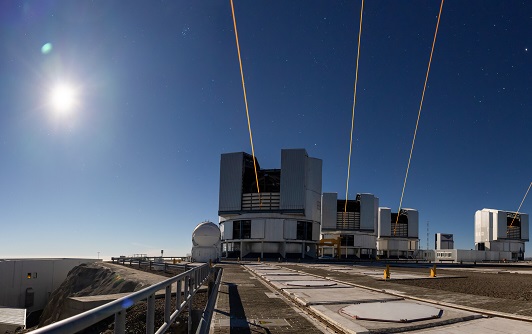Last week, four lasers were projected into the skies above the European Southern Observatory’s (ESO’s) Paranal site in Chile. The lasers are each used to create an artificial star, which astronomers use to measure and then correct the blur caused by Earth’s atmosphere. The striking launch of these lasers, one from each of the eight-metre telescopes at Paranal, is a significant milestone of the GRAVITY+ project — a large and complex upgrade to ESO’s Very Large Telescope Interferometer (VLTI). GRAVITY+ unlocks a greater observing power and a much wider sky coverage for the VLTI than previously possible.
“This is a very important milestone for a facility that is completely unique in the world,” says Antoine Mérand, an ESO astronomer and VLTI Programme Scientist.
París, November 10, 2025.- The VLTI combines light from several individual telescopes of the VLT (either the four eight-metre Unit Telescopes (UTs) or the four smaller Auxiliary Telescopes) using interferometry. GRAVITY+ is an upgrade to the VLTI, with a focus on GRAVITY, a very successful VLTI instrument that has been used to image exoplanets, observe stars near and far and perform detailed observations of faint objects orbiting the Milky Way’s supermassive black hole. GRAVITY+ also encompasses infrastructural changes to the telescopes and upgrades to the VLTI underground tunnels, where the light beams are brought together. The installation of a laser at each of the previously unequipped UTs is a key achievement of this long-term project, transforming the VLTI into the most powerful optical interferometer in the world.
“The VLTI with GRAVITY has already enabled so many unpredicted discoveries, we are excited to see how GRAVITY+ will push the boundaries even further,” says GRAVITY+ Principal Investigator Frank Eisenhauer of the Max-Planck Institute for Extraterrestrial Physics (MPE), Germany, which led the consortium carrying out the upgrade. [1]
The series of upgrades has been ongoing for a few years and includes revised adaptive-optics technology — a system to correct the blur caused by the Earth’s atmosphere — with advanced state-of-the-art sensors and deformable mirrors. Until now, for the VLTI, adaptive-optics corrections have been done by pointing to bright reference stars that need to be close to the target, limiting the number of objects we can observe. With the installation of a laser at each of the UTs, a bright artificial star is created 90 km above Earth’s surface, enabling the correction of atmospheric blur anywhere on the sky. This unlocks the whole southern sky to the VLTI and enhances its observing power dramatically.
“This opens up the instrument to observations of objects in the early distant Universe, such as the quasar we observed on the second night where we resolved the hot, oxygen emitting gas very close to the black hole,” says Taro Shimizu, an MPE astronomer who is a member of the instrument consortium. With lasers on the telescopes used by the VLTI, astronomers will be able to study distant active galaxies and directly measure the mass of the supermassive black holes that power them, as well as observe young stars and the planet-forming discs around them.
The VLTI’s improved capabilities will drastically increase the amount of light that can travel through the system, making the facility up to 10 times more sensitive. “A big goal of GRAVITY+ is to allow for deep observations of faint targets,” explains Julien Woillez, an ESO astronomer and GRAVITY+ project scientist. This increased ability to detect dimmer objects will allow observations of isolated stellar black holes, free-floating planets that do not orbit a parent star and stars closest to the Milky Way’s supermassive black hole Sgr A*.
A first target for the GRAVITY+ and ESO teams at Paranal performing test observations using the new lasers was a cluster of massive stars at the centre of the Tarantula Nebula, a star-forming region in our neighbouring galaxy the Large Magellanic Cloud. These first observations revealed that a bright object in the nebula, thought to be an extremely massive single star, is actually a binary of two stars close together. This showcases the stunning capabilities and scientific potential of the upgraded VLTI.
This improvement is beyond just an update and was first envisioned decades ago. The laser system was suggested in the final report of the “Very Large Telescope Project” in 1986 before the VLTI even existed: “If it could work in practice, it would be a breakthrough,” the report stated. Now this breakthrough is a reality.
Notes
[1] The GRAVITY+ consortium consists of the following partners:
Max Planck Institute for Extraterrestrial Physics (MPE); Max Planck Institute for Astronomy; University of Cologne (Germany)
Institut National des Sciences de l’Univers, French National Centre for Scientific Research; Institut de Planétologie et d’Astrophysique de Grenoble; Laboratoire d’instrumentation et de recherche en astrophysique (LIRA); Lagrange Laboratory; Centre de Recherche Astrophysique de Lyon (France)
Instituto Superior Técnico’s Centre for Astrophysics and Gravitation (CENTRA); University of Lisbon; University of Porto (Portugal)
University of Southampton (UK)
Katholieke Universiteit Leuven (Belgium)
University College Dublin (Ireland)
Instituto de Astronomia – Universidad Nacional Autónoma de México (Mexico)
European Southern Observatory.









